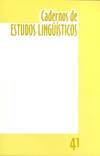Abstract
Starting from the premise that the process of referenciation is neither a simple activity of extensional designation nor of identification or discrimination of beings, individuals, things, facts, situations, states, etc., but a complex interactive decision developed by individuals in specific situations, this paper makes explicit how interlocutors arrive at referential consensus in the public and social use of language. It is based on the idea that reference is much more a situated and interactive action than an explicitation of a language-world relation or an act of affirmation of successful and conventionalized correspondences in the language. In the end, it postulates that our assertions are assertions of beliefs assumed as facts because as Putman says, it is reasonable to take them as facts. Therefore, to refer is essentially a process of explicitation of beliefs, interactively and publicly elaborated and admitted.References
APOTHÉLOZ, Denis & Marie-José REICHLER-BÉGUELIN. (1995). Construction de la référence et strategies de designation. TRANEL 23 – Du syntagme nominal aux objets-de-discours, 227-271.
AUSTIN, John L. 1962. How to do things with words. Oxford, Oxford University Press.
BORTONI, Stella-Maris. (1984). Problemas de Comunicação Interdialetal. Tempo Brasileiro 78/79:9-32.
CLARK, Herbert H. (1992). Arenas of language use. Chicago, The University of Chicago Press.
CLARK, Herbert H. (1996). Using Language. Cambridge, Cambridge University Press.
COOK-GUMPERZ, Jenny & John J. GUMPERZ. (1984). The politics of a conversation: conversational inference in discussion. Berkeley Cognitive Science Report Series. Institute of Cognitive Studies. University of California at Berkeley. Mimeo, 19 pp.
DONNELLAN. (1966). Reference and Definite Descriptions. The Philosophical Review 77. 281-304.
FAUCONNIER, Gilles. (1985). Mental Spaces. Cambridge, Cambridge University Press.
FAUCONNIER, Gilles. (1997). Mappings in Thought and Language. Cambridge, Cambridge University Press.
GOFFMAN, Erving. ([1979]. 1998). Footing. In: B. TELLES RIBEIRO & M. GARCEZ (orgs). Sociolingüística Interacional. Porto Alegre, Age Editora, pp. 70-97.
GRICE, Herbert Paul. (1968). Utterer’s meaning, sentence-meaning, and word-meaning. Foundations of Language, 4, 225-242.
GRICE, Herbert Paul. (1975). Logic and conversation. In: P. COLE and J.L. MORGAN (eds). Syntax and Semantics 3: Speech Acts. New York, Seminar Press, pp. 41-58.
GUMPERZ, John (1982). Discourse Strategies. Cambridge, Cambridge University Press.
GUMPERZ, John (ed.) (1982). Language and Social Identity. Cambridge, Cambridge Univ. Press. (Uma série de textos sobre interação intercultural e inter-étnica).
LEVINSON, Stephen (1979). Activity Types and Language. Linguistics 17: 365-399.
LEVINSON, Stephen (1981).The essential inadequacies of speech act models of dialogue. In: H. PARRET (ed.), Possibilities and Limitations of Pragmatics. Amsterdam, John Benjamins, pp.473-492.
LEVINSON, Stephen. (1980). Speech act theory: The state of the art, Language Teaching and Lingüístics: Abstracts, 13:5-24.
MARCUSCHI, L. A. (no prelo 2001). Anáfora indireta: o barco textual e suas âncoras. A sair nas Atas da IV Jornada do CelSul, Curitiba, novembro de 2000. mimeo.
MAZELAND, Harrie (1986). Short note on Gumperz's contextualization cues. Osnabrucker Beitraege zur Sprachtheorie. 33:170-182.
MEY, Jacob L. 1993. Pragmatics. An Introduction. Oxford, Blackwell.
MONDADA, Lorenza. (1994). Verbalisation de l’Espace et Fabrication du Savoir. Lausanne, Université de Lausanne, Faculté de Letres [Tese de Doutorado].
MEY, Jacob L. (1997). Processus de catégorisation et construction discursive de catégories. In: D. Dubois (Org.). Categorisation et cognition: de la perception au discours. Paris: Éditions Kimé, pp. 291-313.
MONDADA, L. e D.DUBOIS (1995) Construction des objets de discours et categorisation: une approche des processus de référenciation. In: BERRENDONNER, A. e M-J. REICHLER-BEGUELIN (eds). Du syntagme nominal aux objets-de discours. SN complexes, nominalisations, anaphores. Neuchâtel, Institute de Linguistique de l’Université de Neuchâtel. TRANEL 23: 273-302.
PUTNAM, Hilary. (1992). Razão, Verdade e História. Lisboa, Publicações Dom Quixote.
SALOMÃO, Margarida. (1999). A questão da construção do sentido e a revisão da agenda dos estudos da linguagem. Veredas, Revista de Estudos Lingüísticos. Juiz de Fora. Vol. 3, (1): 61-79.
SCHIFFRIN, Déborah. (1987). Discourse Markers. Cambridge, Cambridge University Press.
SCHWARZ, Monika. 2000. Indirekte Anaphern in Texten. Tübingen, Max Niemeyer.
SEARLE, John R. (1969). Speech acts. Cambridge, Cambridge University Press.
SEARLE, John R. ([1979]. 1995). Expressão e Significado. Estudos da teoria dos atos de fala. São Paulo, Martins Fontes. [Em especial o texto “Significado literal” pp. 183-250].
SEARLE, John R. (1998). Mind, Language and Society. New York, Basic Books.
SETTE, Neide Durães (1980). Formas de Tratamento no Português Coloquial. Diss. ME, Programa de PósGraduação em Letras e Lingüística, UFPE, Recife. Mimeo.
TANNEN, Deborah (1979). What's in a Frame? Surface evidence for underlying expectations. In: R. FREEDLE (ed.), New Directions in discourse processing. Norwood,N.J., Ablex, pp. 137-181.
TANNEN, Deborah (1985). Frames and Schemas in Interaction, Quaderni di Semantica VI: 326-335.
TANNEN, Deborah. (1986). That's not What I Meant! New York, William Morrow & Company.
TOMASELLO, Michael. (2000). The Cultural Origins of Human Cognition. Harvard, Harvard University Press.
The journal CADERNOS DE ESTUDOS LINGUÍSTICOS is granted all the copyright related to the published works. The originals will not be returned. By virtue of being part of this public access journal, the articles are free to use, with their own attributions, in educational and non-commercial applications

